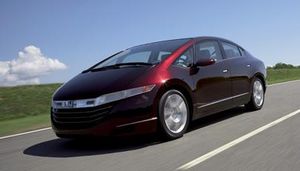.
Honda FCX Concept

| |
| Honda FCX Concept | |
|---|---|
| Honda | |
| aka | |
| Introduction | |
| Class | |
| Body Style | |
| Length | |
| Width | |
| Height | |
| Wheelbase | |
| Weight | |
| Transmission | |
| Engine | |
| Power | |
| Similar | |
| Designer | |
The FCX Concept is Concept Car built by Honda to showcase and display the fruits of their research into the viability of Alternative-Fuel vehicles, specifically Hydrogen-powered cars. There have been several concept vehicles to wear the moniker starting in 1999. Its development later resulted in the leased 2002 prototypes of the FCX. More recently, Honda has developed a concept car in 2002 which has resulted in a fully production-ready vehicle for the 2009 model year, dubbed the FCX Clarity.
See Wikicars' comprehensive <MODEL> Review.
Photos
1999 FCX concept and prototypes
The first prototype FCX is a two-door, four-seat vehicle that was launched in 1999. Dimensions are: length 4165 mm, width 1760 mm and height 1645 mm. The fuel cell was a PEFC (proton exchange membrane) manufactured by Ballard Power Systems. The fuel cell had power output of 78 kW.
The engine has a maximum output of 60 kilowatts (80 horsepower), torque of 201 lb-ft (272 Nm) and has a EPA certified range of 170 miles.
The first vehicles in the USA were delivered in December 2002 to the City of Los Angeles.
- 1999 September
- Honda FCX-V1: Hydrogen vehicle model
- Honda FCX-V2: Methanol-fuel cell model
- 2000 September
- Honda FCX-V3: Ultracapacitor model, began tests in the public roads
- 2001 September
- Honda FCX-V4: evoluated model of FCX-V3
- 2002 December
- Honda FCX: first delivered model, delivered to Japanese Prime Minister's office (Kantei) and Los Angeles City Hall.
2006 FCX concept
At the 2006 Detroit Auto Show, Honda announced that it would make a production version of the concept FCX it had shown at the 2005 Tokyo Motor Show. On 25 September 2006 this new version was unveiled. The updated four-door sedan version looks much more sleek and futuristic, and has a high focus on comfort and interior space. It has a much more spacious interior with a mixture of plastic, wood and leather.<ref>2005 Tokyo Motor Show - Honda FCX</ref> Production is expected to begin in 2008 in Japan and the U.S.<ref>http://www.usatoday.com/money/autos/2007-05-10-honda-fuel-cell_N.htm</ref> The production version will closely resemble the concept, although it is unknown if some of the concept's more radical features, such as a tilting instrument panel, will be included.
According to Honda, the new fuel-cell stack is 20% smaller, 30% lighter and has a higher output of 100 kW (129 hp). The new powerplant is 180 kg lighter, 40% smaller in volume and has a high energy efficiency of 60%, compared with 20% for most internal combustion engines, 30% for most hybrid powerplants and 50% for the previous generation FCX.<ref>FCX - העתיד על-פי הונדה (Hebrew)</ref>
The new powerplant utilizes three electric motors: one front-drive motor with an output of up to 80 kW, this motor's shaft is coaxial with the gearbox for a more compact front-end, and two smaller motors with a maximum output of 25 kW driving one of the rear wheels each. This layout makes the FCX technically an all-wheel-drive vehicle. The updated FCX has a maximum speed of 160 km/h (100 mph).
The new FCX utilizes several interesting new features. The new V Flow fuel cell stack can operate at temperatures as low as −30 °C. This is achieved by allowing the gas to flow vertically in the fuel cell stack. The tanks can store up to 5 kg (171 litres) of hydrogen at a pressure of 350 atmospheres, thanks to the new hydrogen absorption materials used. This allows a longer range of up to 350 miles (570 km).
To support the hydrogen fuel-cell technology, Honda also introduced the Home Energy Station (HES). This home solution can convert natural gas to electricity, heat and hydrogen to refuel fuel-cell vehicles. This allows consumers to refuel vehicles with hydrogen at home, important until hydrogen stations become widespread. Alternatively, the hydrogen can be used in the HES's built-in hydrogen fuel cell, providing up to 5 kW of normal or backup electricity and/or hot water for the home. According to Honda, this solution is highly efficient and reduces running costs of electricity, gas and vehicle fuel by up to 50%.
Unique Attributes
If there are any features of this vehicle that sets it apart from other vehicles in its class, then mention those unique attributes here.
Criticisms
Please make sure to keep critiques in a third-person point of view. If using criticisms from a reputable automotive source, then please make sure to cite the quote.
Worldwide
If the vehicle is sold in other markets worldwide, then this is the section to mention that information. Also, mention if the <MODEL> goes by another name in these other markets.
Design quirks and oddities
Refer to any pop-culture tidbits about the vehicle in this section.
Awards
List out notable awards that the model has recieved while in production. Boldface the company or orgainization that gives out the award, and Italicize the name of the award.
See also
External Links
Please include any external sites that were used in collaborating this data, including manufacturer sites, in this section.
